|
SHISHI 獅子 PHOTO TOUR
This is a side page. Return to Main Shishi Page.

SHISHI (also Korean Dog, Chinese Lion)
SHINTŌ SHRINE & BUDDHIST TEMPLE GUARDIANS

Shishi under Temple Eaves
Engakuji Temple 円覚寺 (Kita Kamakura)
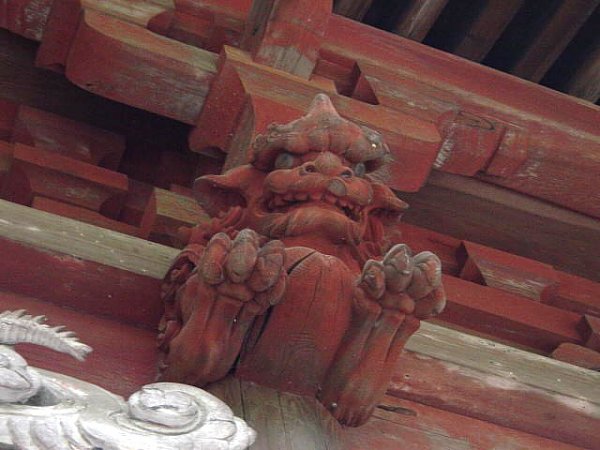
Shishi under Temple Eaves
Myōhonji Temple 妙本寺, Kamakura
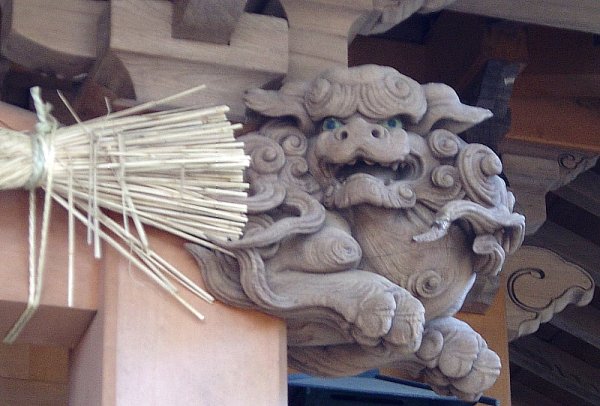
Shishi adorning temple-shrine multiplex in Kamakura
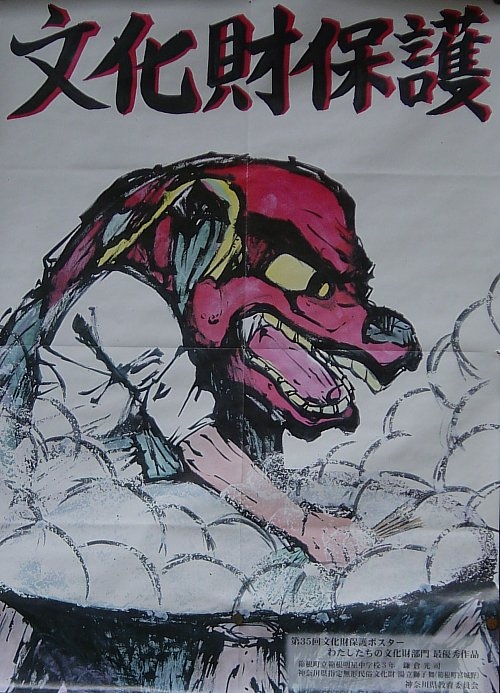
Kanagawa Prefecture Cultural Assets Poster - 第35回文化財保護ポスター
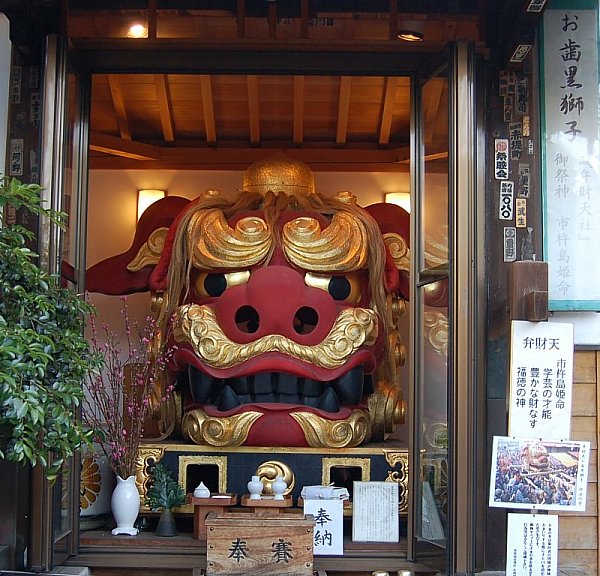
Namiyoke Inari Shrine 波除稲荷神社, near the Tsukiji fish market in Tokyo.
The shrine venerates Inari (rice kami), foxes (messengers of Inari), shishi lion protectors,
and a curious black-toothed form of Benzaiten (goddess of water, good fortune, & agriculture).
The shrine’s shishi effigies are said to be manifestations of Inari and Benzaiten.
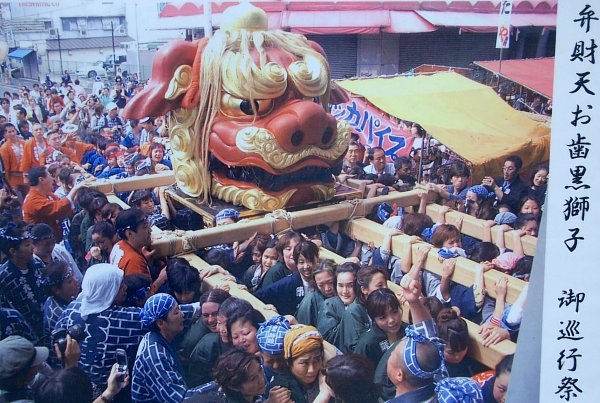
Women carrying the 700-kg black-toothed shishi called “Benzaiten Ohaguro Shishi.”
Namiyoke Inari Shrine 波除稲荷神社, Tsukiji Shishi Matsuri (Lion Festival).
Photo of a photo on display at Namiyoke Inari Shrine.
People come to this shrine to pray for business success and safe construction (of buildings), and to gain protection against misfortune. The 350-year-old shrine holds the Tsukiji Shishi Matsuri 築地獅子祭 (Lion Festival) and parade annually in mid-June. The festival features a 700-kg black-toothed female shishi known as the Benzaiten Ohaguro Shishi 弁財天お歯黒獅子 (Benzaiten Black-Toothed Shishi) and the male Tenjō Ōjishi 天井大獅子 (Great Heavenly Shishi). These are paraded around the nearby area, but only women are allowed to carry the black-toothed female shishi, while only men can carry the male shishi. Other effigies of the lion-dog (those owned by local parishioner groups) are carried around as well. According to the shrine, construction of the shrine during the Edo period ran into difficulties due to ocean tides (the shrine is located near the sea). When construction seemed impossible, an image of Inari miraculously floated into view and construction was completed successfully. The image is reportedly housed inside the shrine. For a few more details, see this E-site as well as this E-site.
A Note on Black Teeth. Says Gina Collia-Suzuki in Floating Along in the World of Japanese Prints: "Ohaguro お歯黒, or teeth blackening, was a common practise amongst married women, with the dye being applied for the first time just before a young bride entered her husband's home. It was also practised within the Yoshiwara, where a young kamuro (apprentice) who was about to come of age and accept her first customer would collect the ingredients from seven friends and dye her teeth for the first time, just as the soon-to-be bride would collect the ingredients from friends and family before her wedding." <end quote> The tradition of blackening teeth goes back to Japan’s ancient period. Over time, it came to symbolize many things, such as coming of age or maturity, and served as a signal that a woman was married. The exact meaning of the black-toothed Benzaiten Shishi (see above photo) escapes me, but Benzaiten is said to be a jealous deity, one identified with many curious practices and taboos that, if not followed, will lead to the breaking up of loving couples or happily married people.
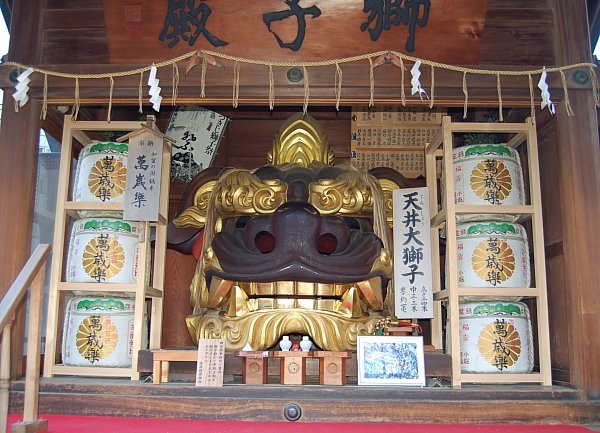
The male shishi, known as Tenjō Ōjishi 天井大獅子 (Great Heavenly Shishi), surrounded
by sake barrels. Namiyoke Inari Shrine 波除稲荷神社, near the Tsukiji fish market in Tokyo.
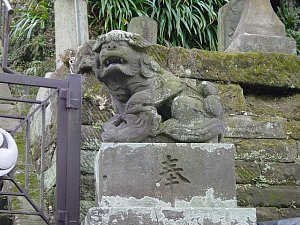 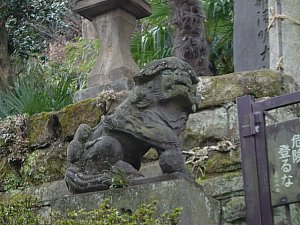
Shishi at Ennō-ji 円応寺 in Kita Kamakura (Arai-enmadō 新居閻魔堂)
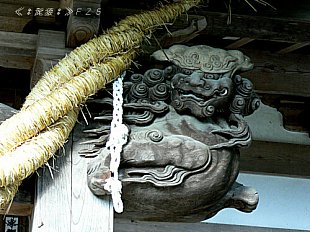 
Shishi at Ōtaki Jinja 大滝神社
Echizen City 越前市, Fukui Prefecture 福井県
Above two photos courtesy this J-site.

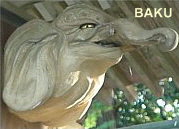 RELATED ARTWORK RELATED ARTWORK
Like images of the shishi, effigies of Baku 獏 (a mythological Chinese creature thought to devour nightmares) are commonly placed under the eaves of Japanese temples to ward off evil spirits. Images of the dragon are also found frequently as decorative architectural elements at temples, less so at shrines. Baku rose to popularity in Japan’s Edo period (1603 to 1868). The character for Baku 獏 is sometimes written on the sail of the Treasure Boat of Japan’s Seven Lucky Gods.
All photos by Mark Schumacher unless otherwise specified.
This is a side page. Return to Main SHISHI Page
|